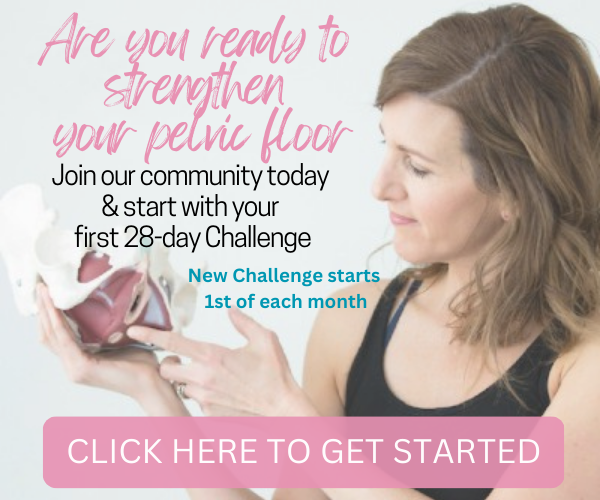
Kegels & Pelvic Floor Exercises for Pregnancy and Birth
Nov 25, 2022I get a lot of questions from women who are expecting and who are interested in finding out the benefits of performing Kegels exercise during pregnancy. Having questions is natural, and I’m so grateful for my education as a trainer to be able to educate my clients about doing Kegel exercises in pregnancy and to be able to address their concerns.
They worry about if it’s safe to keep doing their Kegels now that they are pregnant or if pregnancy is a time that they should start doing them if they haven’t been doing them before. They wonder how to do Kegels and when they should start doing them if they are pregnant, and also if there is an ideal time.
As a passionate promoter of pelvic health for 14 years, women come to me with a lot of questions about pelvic wellness at all stages of life, prenatal, postnatal, or even if they never plan to have a child. Kegels are foundational to pelvic wellness. I have had the fortune to partner with and learn from urogynecologists, pelvic floor physiotherapists and movement professionals that helped me bring fun and fitness into the world of pelvic health.
Today I will answer your burning questions about this important part of prenatal pelvic wellness so you can set yourself up for the best birth, recovery, and pregnancy possible.
Are Kegels safe during pregnancy?
One of the main questions I get about Kegel exercises for pregnancy is, “Should you do them or shouldn't you do them?” It’s understandable to wonder why there are many things you shouldn’t do during pregnancy, and it’s a good idea to ask whether a given activity is safe to start or continue during pregnancy.
After so many years of supporting women's pelvic wellness, I believe you should do Kegels during pregnancy. I would also say that it’s not only safe but also an important thing to prioritize. It’s important to do Kegels during pregnancy to help you train for birth and to set you on the road to success for a healthy postpartum.
But there is a caveat we need to discuss so that you do them the right way. Spoiler: the way you do them during pregnancy will be a little bit different than you’re used to doing them when you aren’t pregnant. Don’t worry; I’m going to explain everything so you know exactly what to do, what not to do and why it matters.
How Do You Do Kegels When You Are Pregnant?
One of the important pieces to understand is that, in pregnancy, what’s happening anatomically is that our uterus is growing up and then out in front of us. From a mechanical perspective, that shifts the center of gravity, which we try to accommodate with different positioning of our pelvis. We need pelvic floor muscles that can respond to those changes, and Kegels are important for developing that level of responsiveness.
We also have an ever-increasing load on the pelvic floor as the baby grows bigger and bigger inside you. That’s why we want to have pelvic floor muscles that are strong. We need to have pelvic floor muscles that can withstand that ever-increasing load.
We also want pelvic floor muscles that are supple and that can release tension. We want them to be able to find ease, surrender and relax as well. We don’t want those muscles to be too tight, so we need to be sure to account for that in our exercises.
That need for strong and supple muscles is why Kegels in pregnancy are so important for pregnant women to do. Kegel exercise for pregnancy will help keep those muscles strong and able to withstand all the changes happening with a growing baby and shifting demands on your pelvic floor. Our bodies like to move, and when we move in ways that harness our pelvic power, we prepare for birth functionally!
How Can Kegels Improve My Birth Experience?
Pelvic floor muscles also play a role in birth. As the baby is descending into the pelvis, when their head reaches the pelvic floor, there needs to be a little bit of tone in those muscles. That level of tone helps guide the baby into those rotations, the movements, the cardinal movements of birth. Toned pelvic floor muscles facilitate the magical internal dance of birth.
By doing these exercises conscientiously, we want to ensure that the pelvic floor can also respond by opening. That’s crucial because, at the end of the day, we need this space to be able to open freely so the baby can pass through.
We need to have responsive pelvic floor muscles so that there's not as much tension in the pelvic floor, creating resistance for the baby. Doing Kegels helps your pelvic floor muscles usher your new baby into the world more easily.
When should I start Kegels during pregnancy?
Kegels can be done safely throughout pregnancy, but the more we can practice inhaling and then exhaling while keeping that space open in those last weeks of pregnancy, the more likely it is that that will translate to our pelvic floor muscles being able to respond appropriately in labour as well.
Labour is probably the most demanding event you will ever do. A trained body performs better, especially if you have trained with the principle of specificity. This principle states that you should train using movements and exercises that mimic the event you are training for.
Birth is your event!
A balanced training program during your pregnancy is key to achieving these objectives and improving your birth experience.
For that reason, when women ask me, “Should I do Kegels during pregnancy?” My answer is always, “Yes, you should do them, but make sure you do them with the modification that I recommend for pregnant women specifically.” I want to see more women feeling strong and confident for birth and ready to take on life’s challenges armed with the information they need to do so.
Birth is a natural process, but you still need to get your body prepared for it, and Kegels are helpful for getting your pelvic floor as prepared as possible for the big day! My Birth Like A Boss Challenge takes the principle of specificity and applies it to pregnancy fitness.
You will learn how to do Kegels and combine them with exercise that trains your body for birth and mimics the most effective birth positions. And you will incorporate functional fitness that prepares you for all the lifting, pushing, pulling, rotating, and squatting you will do in motherhood.
I designed this program to be easy to follow and fit into your day. You will learn about adaptations of pregnancy and what you can do to support and train your body.
The 28-Day Challenge and Buff Muff Membership
I recommend checking out my comprehensive pelvic health education and fitness programs on my Buff Muff App. The most complete Pelvic Floor & Kegel exercise App.
The Buff Muff 28-Day Challenge (housed in the App) gets you started, and the Annual membership keeps you progressing so you can laugh, run, jump, and lift without the pesky leaks and annoying discomfort of prolapse symptoms.




